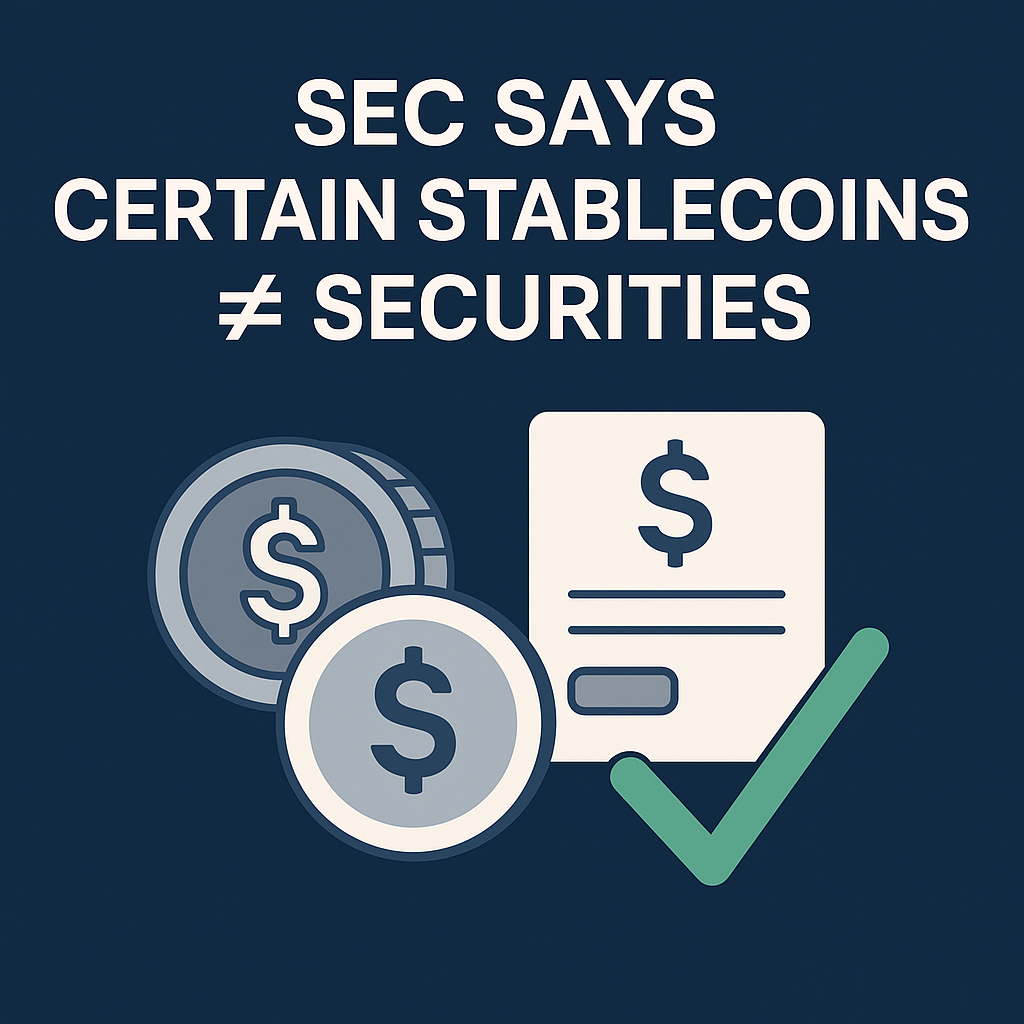
On April 4, 2025, the U.S. Securities and Exchange Commission (SEC) took a significant step in clarifying its stance on stablecoins—crypto assets designed to maintain a stable value relative to a fiat currency, typically the U.S. Dollar. The Division of Corporation Finance issued a public statement outlining specific criteria under which stablecoins would not be considered securities, thus exempting them from SEC registration requirements under federal securities laws.
This moment could mark a turning point in how regulators view digital assets that attempt to mirror fiat currency. It also opens up opportunities for innovation in payments, decentralized finance (DeFi), and global value transfer, while also raising new questions about regulatory boundaries, risk, and the future of financial infrastructure.
What Are Stablecoins?
Before diving into the SEC’s statement, it’s important to understand the role of stablecoins in the digital asset ecosystem. Unlike cryptocurrencies like Bitcoin or Ethereum, which can be highly volatile, stablecoins aim to maintain price stability. They are typically pegged to reserve assets such as the U.S. Dollar, the Euro, or even commodities like gold.
There are various mechanisms through which stablecoins maintain their peg:
-
Fiat-backed: These stablecoins hold reserves in fiat currency or cash equivalents, allowing for a 1:1 redemption.
-
Crypto-collateralized: Backed by cryptocurrencies but typically overcollateralized to absorb volatility.
-
Algorithmic: Rely on smart contracts and algorithms to control supply and demand to maintain a stable price.
Fiat-backed stablecoins—like the ones addressed in the SEC’s April 2025 statement—are among the most widely adopted and are considered integral to bridging traditional finance and decentralized applications.
The SEC’s Position: What Changed?
In its statement, the SEC’s Division of Corporation Finance clarified that the offer and sale of certain fiat-backed stablecoins, referred to as “Covered Stablecoins”, do not constitute securities transactions under federal law. This means that issuers of these specific stablecoins are not required to register their offerings with the SEC, provided they meet defined conditions.
Criteria for “Covered Stablecoins”
According to the SEC’s statement, for a stablecoin to fall under this non-securities classification, it must meet the following two criteria:
-
Pegged to the U.S. Dollar with One-to-One Redemption Rights
The stablecoin must be designed to maintain a constant value relative to the USD and allow holders to redeem tokens for USD at a one-to-one rate. -
Backed by High-Quality, Liquid Reserve Assets
The issuer must maintain a reserve of assets that is low-risk, highly liquid, and at least equal in value to the total supply of stablecoins in circulation.
These conditions are meant to ensure both the price stability and financial soundness of the stablecoin, thereby mitigating the risk to consumers and market participants.
Why This Matters
For the past several years, regulatory ambiguity has been a major obstacle for both issuers and users of stablecoins. The lack of clarity created a chilling effect on innovation and left projects vulnerable to enforcement actions. By formally stating that Covered Stablecoins do not constitute securities, the SEC is sending a powerful message: not all digital assets fall within the traditional definitions of securities.
This opens the door for U.S.-based stablecoin issuers to operate with greater confidence, provided they follow strict guidelines. It could also encourage more institutions and fintech platforms to integrate stablecoins into their services, thereby accelerating adoption in both consumer and institutional markets.
A Win for Clarity—But Not a Free Pass
While the SEC’s position brings welcome clarity, it is not a blanket exemption for all stablecoins. Many other types of digital assets, including stablecoins that do not meet the outlined criteria, could still fall under the jurisdiction of securities laws. Additionally, the SEC emphasized that this statement does not address other regulatory frameworks, such as those under the Investment Company Act of 1940 or banking regulations.
This means that stablecoin issuers must still navigate a complex web of potential oversight by the Treasury Department, the Commodity Futures Trading Commission (CFTC), the Office of the Comptroller of the Currency (OCC), and state regulators.
Commissioner Crenshaw’s Dissent
Not everyone at the SEC is in full agreement with the statement. Commissioner Caroline A. Crenshaw issued a dissenting opinion that highlighted several concerns. Most notably, she argued that the statement:
-
Understates Risks to Consumers: By not treating stablecoins as securities, regulators may be giving up a layer of investor protection that would otherwise apply.
-
Overlooks Intermediaries: Crenshaw noted that while the stablecoin itself may be backed by secure assets, the network of issuers, redeemers, and platforms could pose systemic risk.
-
Lacks a Holistic Risk Framework: She advocated for a broader assessment of market structure, redemption mechanisms, and how stablecoins operate in practice—especially in times of stress.
Her comments underscore the ongoing tension within regulatory agencies over how to balance innovation with systemic risk mitigation.
Industry Reactions
The crypto and fintech industries largely welcomed the SEC’s clarification, calling it a positive step toward a more predictable regulatory environment. Several prominent stablecoin issuers praised the move, stating that it would allow them to enhance compliance, expand access, and build more robust consumer protections.
Legal experts noted that the decision could influence future litigation and enforcement actions. By clearly defining the characteristics of Covered Stablecoins, the SEC is offering a potential model for other digital asset issuers seeking to avoid classification as a security.
However, there is also caution. As one fintech attorney pointed out, “This doesn’t mean we’re in the clear. The criteria are specific, and the scope is narrow. One misstep—such as a change in reserve composition or redemption policy—could put an issuer back in regulatory crosshairs.”
Broader Implications for Digital Finance
The SEC’s statement could have broader implications beyond just stablecoins. Here’s how:
1. Accelerating Tokenized Finance
If more assets like stablecoins are deemed outside the SEC’s purview, it could catalyze tokenization efforts in other areas—such as real estate, private equity, and bonds. Tokenized assets could benefit from similar regulatory clarity, provided they follow robust backing and redemption standards.
2. Encouraging CBDC Development
Stablecoins are often seen as precursors to Central Bank Digital Currencies (CBDCs). By clarifying that certain fiat-pegged tokens are not securities, regulators might also be laying groundwork for private-public collaborations in digital dollar initiatives.
3. Influencing Global Standards
The SEC is one of the world’s most influential regulators. Its stance may influence how other jurisdictions classify stablecoins, potentially encouraging harmonization across borders.
4. Market Confidence
The SEC’s clarity can restore or enhance market confidence in compliant stablecoin projects. Investors, users, and institutions will feel more comfortable engaging with digital dollars that are recognized by regulators as operating outside the securities framework.
What Comes Next?
This is not the end of the conversation—far from it. While the SEC has offered guidance for a very specific type of stablecoin, many questions remain unanswered:
-
How will regulators treat algorithmic or crypto-backed stablecoins?
-
What kind of disclosures will still be required from issuers of Covered Stablecoins?
-
Will Congress enact broader legislation to define and regulate digital assets?
-
How will this affect DeFi protocols that rely on stablecoins for liquidity and lending?
In addition, the Financial Stability Oversight Council (FSOC) and the President’s Working Group on Financial Markets have both flagged stablecoins as a potential risk to financial stability. It’s likely we’ll see more interagency coordination and possibly even legislation aimed at setting comprehensive standards.
Final Thoughts
The SEC’s April 2025 statement provides valuable guidance for a fast-evolving digital asset landscape. By carving out a regulatory path for Covered Stablecoins, the Commission is giving both issuers and investors a framework within which they can operate more confidently.
However, that confidence comes with responsibilities—chief among them: transparency, strong governance, and unwavering commitment to maintaining reserve integrity. The market will reward those who meet these standards, and regulators will scrutinize those who don’t.
As the digital asset economy matures, regulatory clarity like this will play a critical role in shaping how innovation unfolds. Stablecoins might not be securities, but they are clearly becoming a cornerstone of modern finance.
Sources:




